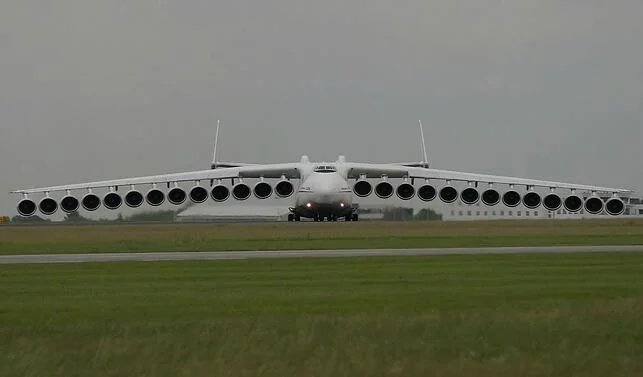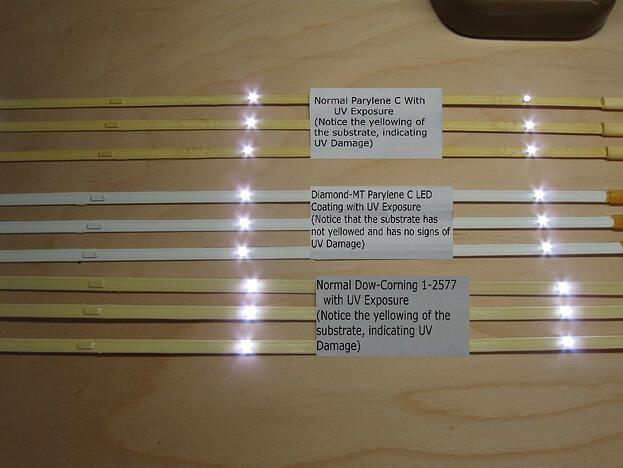With a precursor requiring a three-step synthesis process, parylene AF-4 is more costly to manufacture; overall yields are limited compared to other parylenes.
How it's Used
Superior to liquid coatings like acrylic, epoxy, silicone and urethane, parylene conformal films offer unparalleled protection for aerospace printed circuit boards (PCBs) and related electronic assemblies. Their complete encapsulation conforms entirely to all device surfaces – flat, round, creviced or edged, while adding almost no weight to the covered device.
These properties are largely the result of parylene’s unique chemical vapor deposition (CVD) process, which applies gaseous parylene deep within PCB surfaces, generating an authentically conformal, micro-thin coating. Parylene coatings also:
Parylene can be attached in exceptionally small spaces. Stress free, parylene is highly resistant to fungi and solvents.
More than this, parylene is a military specification conformal coating (MIL-I-46058), suitable for aerospace assemblies, which are seldom adequately protected by standard liquid brush-on, dip, and spray coating methods. In general, liquid coatings working without fail for consumer devices lack the longer-term, ruggedized resilience required for prolonged aerospace use. The lightweight, highly durable parylene conformal coating alternative provides optimal protection for the full-device aerospace service life, regardless of how and where it is used. Parylene is also hydrophobic and can withstand a 100-hour salt spray test, which exceeds the MIL-STD-810F ruggedization standard.
Microelectromechanical (MEMS) Applications
A major aerospace application for parylene conformal coatings is protecting MEMS, nano-tech and other multiple-layer circuit instrumentation. These typically include cockpit, engine management, flight control, and sensor systems located throughout the in-flight vehicle. In these situations, PCBs benefit from the exceptional thermal stability generated by parylene film, ranging from 80 degrees Celsius longer-term, to 450` C, shorter-term.
Parylene’s low dielectric constant and dissipation features allow:
In particular, Parylene AF-4 offers an advanced aerospace solution for instrumentation requiring superior protection for enhanced performance reliability.

Ultraviolet (UV) Protection
Prolonged exposure to high energy UV radiation can generate extensive surface damage and lead to eventual equipment malfunction of, for instance, electrical, light-generating LED assemblies within. Newer high-temperature, UV-stable parylene formulations (AF-4) meet the challenge of UV degradation to aircraft LED-lighting, preventing LED-yellowing and surface discoloration from prolonged exposure to UV radiation. By filtering UV light from the coated item, parylene protects internal LED assemblies from operational malfunction caused by UV radiation, sustaining their performance as energy-efficient, long-lasting sources of cabin-, landing gear-, and navigation lighting.
Parylene provides lightweight conformal, pinhole-free covering, that is both heat- and UV-resistant. It generates enhanced LED protection through prolonged exposure to aerospace environments, at minute surface thicknesses ranging from 500 angstroms to 75 microns. In comparison to other parylene types, AF-4 provides 2,000 or more hours of UV-usage without suffering decomposition or surface yellowing, effective with a much thinner protective coating layer.
Communications/Electronics
Aerospace electronic systems are frequently subjected to extremes in temperature and vibration, as well as the incursion of in-flight particulates of questionable origin. Computerized and radio internal/external communications equipment require highest level protection to assure ongoing function. Additional effected electronics systems include:
Parylene adheres mechanically, rather than chemically, to a given substrate, protecting specialized aerospace electrical systems; its dielectric properties prevent crosstalk and interference for these protected devices.
External Operations
Reliable ruggedized protection is a necessity for circuits situated externally. For instance, aircraft wing/tail applications are subject to rapid-change, non-controlled operating environments, exposed to often extreme atmospheric changes. These conditions frequently exceed the security parameters provided by liquid conformal coatings. Parylene coating protects these assemblies, ensuring appropriate function as the aircraft moves from sea level to upper atmospheric operating altitudes, enabling PCBs, sensors and similar devices to perform according to design expectations for both commercial/industrial and military aerospace applications.
Parylene film's high strength, low permeability, and resistance to temperature extremes make it an effective protector of exposed surfaces such as optical windows, radiation detectors, and radar transmitters. It repels abrasive substances, chemicals, corrosive liquids, and moisture, simultaneously providing lightweight barrier protection without the significant dimension or mass of liquid coatings.
Conclusion
Aerospace applications expand parylene coating technologies, leading to enhanced performance and lifespan of mission critical PCBs, communication devices, power supplies, radar/detection equipment, even satellite electronics.
A Cost Comparison
Perhaps the most reliable of the conformal coatings, parylene (para-xylylene di-iodide) is also one of the more expensive coating options. Production costs typically encompass three primary expense categories -- raw materials, labor, and lot volume. Of the three, labor expenses are generally the most costly, but raw materials can add significantly to production overhead; materials’ costs can be largely attributed to the raw parylene dimer required to make conformal coatings.
Parylene CVD and Dimer Requirements
The parylene chemical vapor deposition (CVD) process is unique and generates the most reliable of conformal coatings for an abundance of products and purposes. CVD causes a gaseous parylene to seep deep within the substrate surface, producing a micro-thin protective film of exceptional durability. But parylene does not start as a vapor; its begins as a solid state raw dimer (di-p-xylene) that is transformed into a gas during CVD.
A chemical compound in a powder form, raw dimer is the essential ingredient of parylene conformal coatings. During CVD, the dimer undergoes pyrolysis in a vacuum environment, maintained throughout the process. It is then transformed from a solid state into a monomeric vapor. Cooled to room temperature, gaseous parylene dimer polymerizes at a very low pressure, and becomes a structurally continuous film that entirely conforms to the physical configurations of the substrate surface. Polymerization occurs at near-room temperature.
In addition to completely uniform, pinhole-free coverage, parylenes typically provide exceptional resistance to solvents and moisture, as well as incredible dielectric strength. Not all parylenes are equal; while all share nonpareil barrier properties, each type has a distinct set of coating properties compared to other parylenes. Major dimer types include Parylene C, Parylene N, Parylene D, and Parylene AF-4, among the most frequently used parylene compounds. Other variants are also possible; their selection and use depends upon the necessities of the specific coating assignment.
Dimer/Project Costs
For instance, required coating thickness factors into the kind of parylene dimer used and its quantity. Regarding cost, the amount of raw dimer needed to produce the required film thickness across the assembly needs to be carefully calculated for optimal results. This issue emerges because parylene can be effectively deposited in thicknesses ranging from angstroms to well over 2 millimeters; determining precise project thickness helps ensure application of the correct dimer type and its expense to the client/manufacturer.
In addition, each of the different types of raw dimer has its own associated manufacturing processes and costs. Thus, different projects and their diverse assembly/component functions are best served by different grades of parylene coating. Other necessary project properties, such as
Further add to the need to appropriately select the correct dimer type used to initiate CVD and the coating process. These conditions combine with the cost of the CVD itself to sum total expenses. Depending on the coating type and required thickness, typical parylene deposition rates are about .2/mils per hour, so machine runs can vary from as little as 1 hour for small production batches to over 24 hours for larger-scale projects.
The majority of parylene product runs -- wherein the dimer is polymerized and applied as conformal coating to the selected substrate -- require about a pound of raw parylene dimer. Depending upon the project and the type of dimer necessary for effective completion, dimer costs between $ 200.00 to $ 10,000,00 per pound, a sizable expenditure range. Selecting the appropriate dimer type is paramount to successful coating. Saving money on dimer cost – opting for a less expensive dimer variant – is never recommended. The resultant conformal film will inevitably malfunction, performing well below standard and leading to assembly breakdown.
The extra cost for parylene coatings is well worth it, considering their exceptional operational versatility. Dimer costs are high, but their appropriate selection leads to longer-lasting, better coating quality and more reliable performance, the most recognized and respected characteristic of parylene coatings.
Comparing Parylene
Applied in a gaseous form to component surfaces through a chemical vapor deposition (CVD) process, parylene (Poly-para-xylylene) films protect printed circuit boards (PCBs) and similar electrical assemblies. Gaseous CVD application supports efficient coating of complex component surfaces characterized by crevices, exposed internal areas, or sharp edges. Depending on the specific use, parylene conformal coatings can be effective in the range of 0.1 - 76 microns' thickness, far finer than competing coating materials. Equally as strong, adaptable and versatile parylene protects substrates with
These properties assure the deposited films reliably resist the incursion of acids, bodily fluids, caustic solutions, dust, temperature extremes, water vapor, and numerous other contaminants. In addition to consumer and industrial products, conformal coatings have a wide range of aerospace, automotive, military, and medically biocompatible/implantable device uses. Prominent parylene types include varieties C, N, F, D, and AF-4; each has a range of distinctive uses distinguished by their relatively unique chemical, electrical and physical properties.

Parylene Types and Their Uses
Each specific parylene type is valuable for properties unique to the type; among the most prominent are:
Types C and N exhibit faster deposition rates than most other parylenes, making them useful for a wider range of uses. They also display generally lower levels of trace metal contamination and exceptional resistance to the destructive impact of corrosive chemicals. A third parylene, Type F, has fluorine atoms on its aromatic ring, distinguishing it from Types C and N. Other salient characteristics include:
Other prominent parylene types are:
Conclusion
Vacuum CVD causes parylene to condense on substrate surfaces in a polycrystalline fashion, generating a truly conformal film that is pinhole free and long-lasting. Since other parylene types have deposition rates that are slower and more expensive, most current parylene applications use Types N and C. Although Type N is chemically the most fundamental of the parylenes, Type C is more widely applied as a product/component coating.
Outdoor Applications
Parylene has numerous outdoor applications. However, a major drawback of most parylene types is limited resistance to direct contact with UV radiation. Daylight is the most common source of UV light. Prolonged exposure to its high energy radiation can cause objects extensive surface damage and lead to eventual malfunction of electrical light-generating assemblies within.
This is a significant drawback, since the objective of conformal coatings is the sustain assembly function in the long term. Generally fine when not directly exposed to UV -- as in the many cases where components are internally situated within a product – most generally transparent parylene films yellow and degrade from prolonged contact with sunlight.
Limited UV Protection Provided by Most Parylenes
This is not the case for all types of radiation, where parylene’s coating properties are maintained. For instance, in a vacuum, parylene’s radiation resistance to gamma ray degradation is consistently impressive. Conformal films composed from parylene for types C, D, N. and AF-4 retain electrical and tensile properties at dosages of 1,000 kilograys (kGy), through a dose rate of 16 kGy/hr. However, outside a vacuum and exposed to air, rapid embrittlement develops. Nevertheless, the mentioned parylene types do generate rather reliable gamma ray protection in a vacuum.
The same cannot be said for exposure to UV light (direct sunlight). Much has to do with the substances’ chemical composition:
Diverse UV Protection, According to Parylene Properties
Basically hydrocarbon dimers, parylene types have different properties. Although it has the best surface-permeating capacities of the parylenes, type N is especially susceptible to UV-generated damage. It has a significantly higher oxygen permeability than parylene C, whose composition has an added chlorine atom; Parylene D adds a second chlorine atom. Nevertheless, the superior impermeability of types C and D declines markedly with UV exposure. Oxygen in UV light causes their coating to decompose into aldehydes and carboxylic acids near the conformal film’s surface, yellowing them and reducing their barrier protection, endangering component function.
Parylene AF-4
Parylene AF-4 is the only parylene type that displays a consistent degree of UV-resistance, one wherein performance is maintained relatively long-term. Like the other parylene types, AF-4 also forms an effective, structurally continuous protective film as thin as several hundred angstroms, due to uniqueness of the chemical vapor deposition (CVD) process used to coat substrate surfaces.
Also called aliphatic fluorinate, AF-4 replaces the alpha hydrogen atom of the N dimer with fluorine, and totals 4 atoms. This compositional variation allows AF-4 to generate the lowest parylene coefficient of friction and dielectric constant throughout UV-exposure, and the highest penetrating ability. AF-4 is also useful in high temperature, short-term applications up to 450°C.
Thus, while parylenes C, D, and N provide dependably stable conformal coatings indoors, degradation commences shortly after exposure to UV light. Only parylene AF-4 displays longer-term and consistent resistance to UV light, for wavelengths between 272 – 400 nm; component degradation is eliminated even after 2,000 hours in air. However, AF-4 is the most expensive of the parylenes, with costs between $8,000 and $10,000 per kilogram. Processing for AF-4 adds a necessary third-step to the synthesis of its precursor, generating only low yield and a reduced deposition efficiency during production, driving total costs higher. Less expensive at this stage may be using another substance – acrylic or silicone, for example -- to provide UV-resistance to parylene-coated assembles exposed to UV light.
Table 1 compares the spectra of parylene types C, D, N, and AF-4 to UV light.
| Parylene Type | % Transmittance | Wavelength, nm |
|---|---|---|
| D, Lower range | 0 | 290 |
| D, Mid-range | 75 | 350 |
| D, Upper range | 90 | 398 |
| C, Mid-range | 68 | 348 |
| C, Upper range | 74 | 395 |
| N, Lower range | 0 | 279 |
| N, Mid-range | 81 | 349 |
| N, Upper range | 88 | 397 |
| AF-4, Lower range | 0 | 272 |
| AF-4, Mid-range | 90 | 351 |
| AF-4, Upper range | 91 | 400 |
Diamond-MT has developed a process in which typical parylene C or N can offer UV stability along with the great protection of parylene.

We verified our process with some accelerated UV testing. The results of the UV test of 504 hours accelerated testing with UVB 313 nm cycling between 8 hours UV at 60 degree Celsius and 8 hours condensation at 50 degree Celsius showed that all board substrates survived the test. Normal parylene C and Dow Corning 1-2577 exhibited a fair amount of UV damage, as evidenced by the significant yellowing. Using Diamond-MT’s process prevented the UV damage and is considered the best option.
Summary
This evidence suggests AF-4’s superior coating and resistant qualities for UV uses, throughout the widest UV-wavelength range. The parylene types N, D and C can provide much shorter-term UV protection when treated externally with other coating substances, such as acrylic or silicone; however, even under these conditions UV-protection is limited.
In contrast, parylene AF-4 provides 2,000 or more hours of UV-usage without suffering decomposition or surface yellowing. Moreover, AF-4 is effective with a much thinner protective coating layer. Applied as external coatings to other parylene types, substances like or acrylic or silicone need to be deposited in much thicker layers, severely restricting their applications for the microelectricalmechanical (MEMS) and nano-systems’ functionality rapidly becoming more prominent for most digital assemblies and components. Under these conditions, the prospect of item malfunction or breakdown can actually make AF-4 parylene more economical to use in the long run.